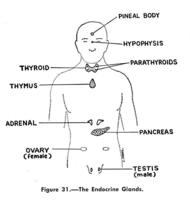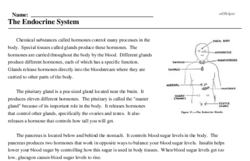The Endocrine System
Chemical substances called hormones control many processes in the body. Special tissues called glands produce these hormones. The hormones are carried throughout the body by the blood. Different glands produce different hormones, each of which has a specific function. Glands release hormones directly into the bloodstream where they are carried to other parts of the body.
The pituitary gland is a pea-sized gland located near the brain. It produces eleven different hormones. The pituitary is called the "master gland" because of its important role in the body. It releases hormones that control other glands, specifically the ovaries and testes. It also releases a hormone that controls how tall you will get.
The pancreas is located below and behind the stomach. It controls blood sugar levels in the body. The pancreas produces two hormones that work in opposite ways to balance your blood sugar levels. Insulin helps lower your blood sugar by controlling how this sugar is used in body tissues. When blood sugar levels get too low, glucagon causes blood sugar levels to rise.
The thyroid gland in the neck produces thyroxine. This hormone controls metabolism in the body. Metabolism is the rate at which the body uses its food. It also controls the storage of calcium in the bones.
The parathyroid glands are located behind the thyroid in the neck. They produce a hormone called parathormone. It regulates calcium and phosphorus in the blood and tissues.




